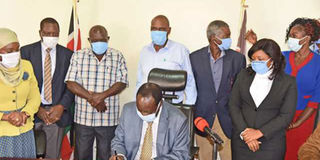Report on Covid-19 expenditure sparks anger over priorities

Governor Wilber Ottichilo signing the Vihiga County Health Facilities Improvement Fund Bill, 2019, and the Health Service Bill, 2019, at the Mbale headquarters on May 14. PHOTO | FILE | NATION MEDIA GROUP
What you need to know:
- Of the Sh1.5 million, Sh175,000 was spent on hiring of a public address system, Sh100,000 on lunch for communication officers while radio advertisements took Sh780,000.
- Medical staff were trained at a cost of Sh2.8 million, the documents show.
- Mr Ijaika noted it was a pity funds have been spent on non-essential areas when locals were struggling under the effects of the pandemic.
Revelations that Vihiga County’s Covid-19 emergency committee spent Sh10.2 million on precautionary measures and other logistics in the first 51 days of the fight against the pandemic has caused an uproar over the expenditures.
The expenditure breakdown which includes Sh655,000 on lunches and another Sh685,000 on allowances paid to members of the rapid response teams is contained in a report compiled by the health department.
The revelations sparked an uproar, coming barely a week after it was revealed that the neighbouring Kisumu County had spent Sh91.8 million on the fight against the pandemic.
Questions have been raised over the expenditures given that the two counties have not reported Covid-19 cases.
SH1.5M MEDIA COVERAGE
The Vihiga Covid-19 committee co-chaired by Governor Wilber Ottichilo and County Commissioner Ochilo Oyugi has consequently come into sharp focus following the statement that was sought by Lugaga/Wamuluma MCA Victor Ijaika. The report was signed by the acting Medical Services chief officer, Dr Richard Boiyo.
The Covid-19 committee spent Sh1.5 million on media coverage. According to the report, the vote on media coverage was used to create awareness to the general public on the dangers and preventive measures of Covid-19.
Of the Sh1.5 million, Sh175,000 was spent on hiring of a public address system, Sh100,000 on lunch for communication officers while radio advertisements took Sh780,000.
Under the same vote, graphic design took Sh40,000, video editing and scripting (Sh171,000), banners (Sh75,000), drinks and another Sh350,000 was spent on snacks and meals during coverage.
According to the documents that will be interrogated by the Health Committee Tuesday, Sh70,000 is said to have been spent on hiring of Live-U and Sh65,600 on hiring of a still camera.
The expenditures saw Sh25,000 spent on the purchase of internet/bundles and Sh61,250 was used to buy DVDs. Sensitisation allowances cost the committee a total of Sh2.6 million with MCAs taking Sh739,750 as their allowance.
MEDICAL STAFF
Medical staff were trained at a cost of Sh2.8 million, the documents show. Dr Boiyo said the documents are a brief report on Covid-19 as at May 20. The documents include the Health Department Work Plan on Covid-19, the third supplementary budget that allocated the committee a total of Sh28 million, receipts and payments and distribution list of items procured so far.
Mr Ijaika noted it was a pity funds have been spent on non-essential areas when locals were struggling under the effects of the pandemic.
In Kisumu, Governor Anyang Nyong’o told the media his administration has invested Sh72.3 million in the acquisition of the Personal Protective Equipment (PPEs) in addition to spending on other commitments.
“Our PPEs acquisition planning is informed by the existing modelling and will be appropriately reviewed in line with the prevailing conditions,” Prof Nyong’o said.
The lakeside county spent Sh19.4 million on surveillance activities.
The county government set up the Kisumu County Covid-19 Response Call Centre in collaboration with Maseno University and Pharm Access on May 6, 2020.
The 24-hour call centre is being run by 18 medical students from Maseno University with the governor saying it has played a key role in the surveillance chain.
As of May 21, 2020, 16 days since the launch, the call centre has processed a total of 4,269 calls from an average of 267 calls per day.
“The facility has become so useful that calls have been received from as far as Mombasa, Nairobi and Marsabit,” said Prof Nyong’o.




